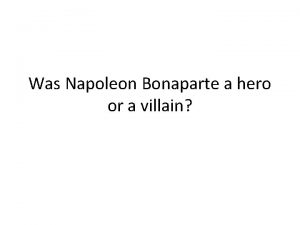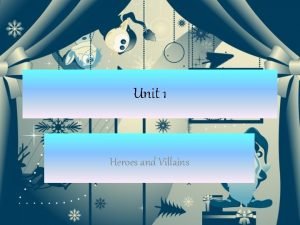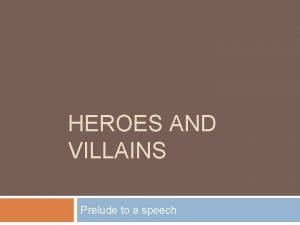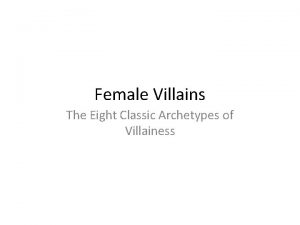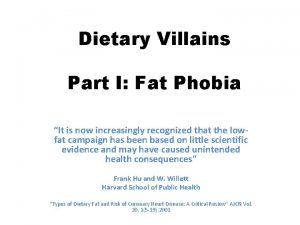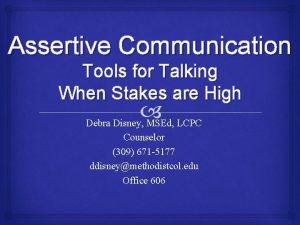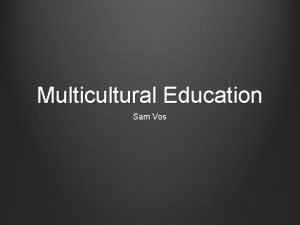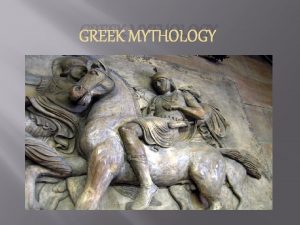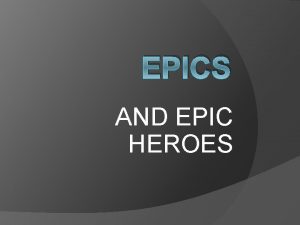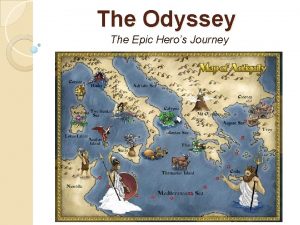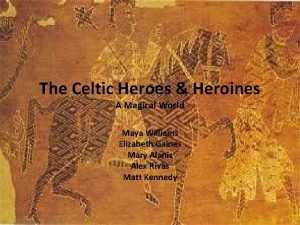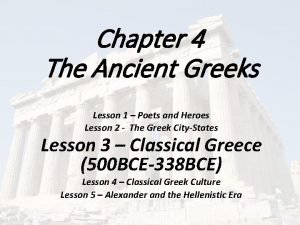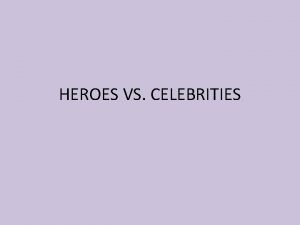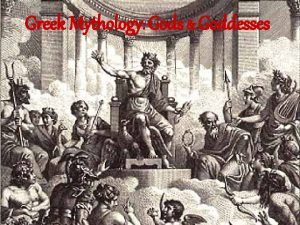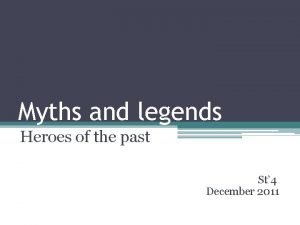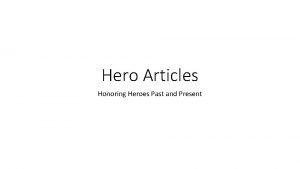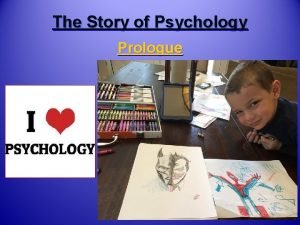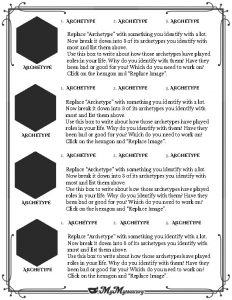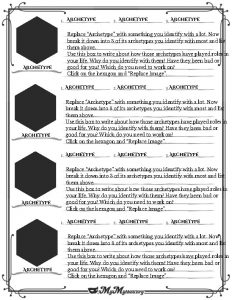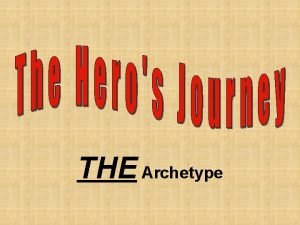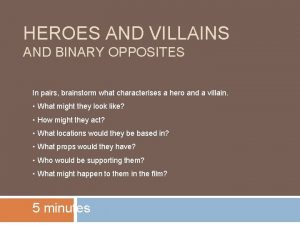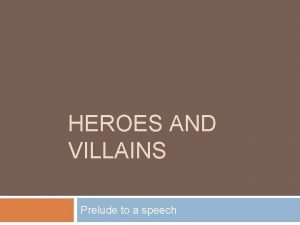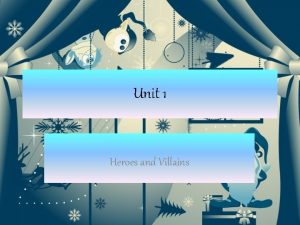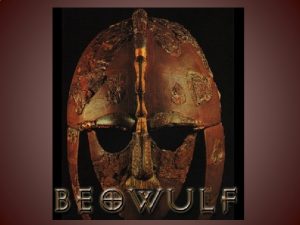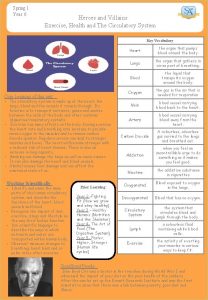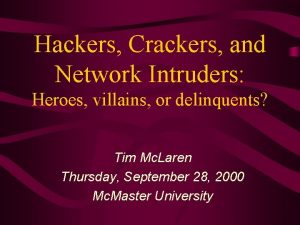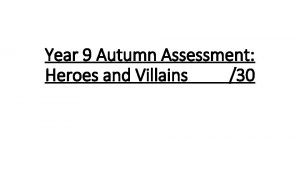Heroes and Villains What is an archetype Psychologist


















- Slides: 18

Heroes and Villains

What is an archetype? Psychologist Carl Jung and scholar Joseph Campbell “propagated” the concept of archetypes but did not create it. They both recognised the recurring pattern of character types, symbols, relationships, and situations in stories across time periods.

Definition l Archetypes are common character types, symbols and relationships that appear often in stories modern and ancient. l The concept of archetypes is an indispensable tool for understanding the purpose or function of characters in a story.

5 Types of Hero l Willing l Unwilling l Anti-Hero l Tragic l Lone

The Hero: 5 types Willing Hero This is a hero who knows he or she is a hero, and embraces this role. Examples: King Arthur, Hercules

The Hero: 5 types Unwilling Hero: This is a “normal” person who is thrust into a situation in which he or she must become a hero. The Unwilling Hero usually turns out to be very brave, wise, and lucky. Examples: Shrek, Neo from The Matrix, Frodo Baggins

The Hero: 5 types Anti-Hero Usually a “bad boy” (or girl) type, who lives on outskirts of society and is an outsider, but has a good heart. Examples: Han Solo, Huckleberry Finn, Robin Hood, Holden Caulfield, John Mc. Clain in Die Hard

The Hero: 5 types Tragic Hero A great person who has one tragic flaw which ultimately brings about his or her downfall. This kind of hero makes the audience feel pity for him or her. Examples: Hamlet, Darth Vader, Oedipus, Othello

The Hero: 5 types Lone Hero Like the Anti-Hero, also usually an outsider. This hero works alone, and may be mysterious. Examples: Indiana Jones, Xena, most American Western cowboys

Archetypes We know them when we see them without even realizing that we know them. Archetypes are l Identifiable l Consistent l Powerful l Innate (from within)

Archetypes Never confuse archetypes with stereotypes. Stereotypes are l Misguided l Erratic l Weak

Archetypes in Heroic Journeys The Hero: GOOD The main character but NOT always admirable. (Not always saving puppies from burning buildings) l audience identifies with him/her l willing to sacrifice on behalf of others. l Examples: David in Montana, Hamlet in Hamlet, Frodo in LOR, many others l

Archetypes in Heroic Journeys The Mentor: GOOD The wise advisor/teacher to the Hero. l Has two responsibilities: teaching the hero life lessons, and giving gifts (often a magical weapon) to the hero. l Often the Mentor is a wise older man or woman l Examples: Yoda, Morpheus (Matrix), Splinter, Cinderella’s fairy godmother l

Archetypes in Heroic Journeys The Shadow: l In direct conflict with the Hero. EVIL l Represents darkness--the Dark Side. l Could also represent the fears of society. l Could be a person (villain) or an idea (racism). l Could be external (outside the Hero, like a villain), or internal (inside the hero, like a tragic flaw). l Examples: Wicked Witch in Wizard of Oz, Claudius in Hamlet, Iago in Othello, also Hamlet’s indeciciveness (internal), Othello’s jealousy, Racism (idea), Procrastination (internal).

Archetypes in Heroic Journeys The Threshold Guardian: l l l EVIL obstacle in the hero’s way. Often an evil henchman of the Shadow. Isn’t always a character—could be mountain, bad weather, bad luck etc. tests the hero’s skills/willingness to continue Can always be overcome by the Hero, and may even be turned into the Hero’s ally Examples: The mountain, orcs, Gollum, in LOR, Flying monkeys in Wizard of Oz

Archetypes in Heroic Journeys The Herald or Harbinger: l l l GOOD or EVIL A messenger who gives the Hero new information. Issues challenges Announces the coming of a significant change. Influences the hero to start the journey. Examples: The messenger in Cinderella, Hagrid in Harry Potter

Archetypes in Heroic Journeys The Trickster: GOOD or EVIL A crazy or comic character—adds comedy even in a serious story. l Creates mischief just for the sake of mischief, even if it causes trouble for the Hero. l Often a sidekick of Hero or Villain. l Examples: The mice in Cinderella, Rafiki in Lion King, Dobby in Harry Potter, Timon and Pumbaa in The Lion King l

Archetypes in Heroic Journeys ? ? ? The Shapeshifter l Mysterious, alliances are unclear—Sometimes actually changes shapes (the love interest? ) l The Hero often wonders: “Is he/she on my side or not? ” l We find out at the end of the story l Lures the Hero on to his/her doom or reward l Examples: Sauruman and Gollum in LOR, Ursula in Little Mermaid, Prof. Snape in Harry Potter,
 Was napoleon a hero or villain
Was napoleon a hero or villain Heroes and villains vocabulary practice appearance
Heroes and villains vocabulary practice appearance Villains speech
Villains speech Villain archetype examples
Villain archetype examples Buccal fat removal malmö
Buccal fat removal malmö O villains make it assertive
O villains make it assertive Youtube-com
Youtube-com Hestia roman name and symbol
Hestia roman name and symbol Traits of an epic hero
Traits of an epic hero Map of odysseus journey
Map of odysseus journey Celtic heroines
Celtic heroines Chapter 4 lesson 1 poets and heroes
Chapter 4 lesson 1 poets and heroes Heroes vs hero's
Heroes vs hero's Traditional story about gods and goddesses
Traditional story about gods and goddesses The legend of king midas
The legend of king midas Heroes past and present
Heroes past and present Educational psychologist wirral
Educational psychologist wirral Psychodynamic psychologist
Psychodynamic psychologist Was maslow a humanistic psychologist
Was maslow a humanistic psychologist
